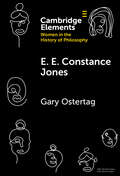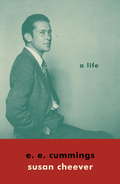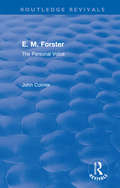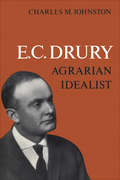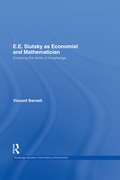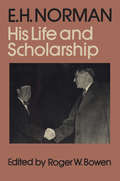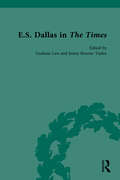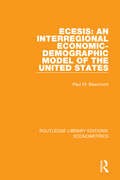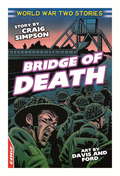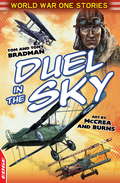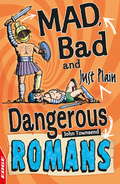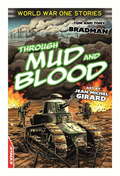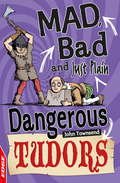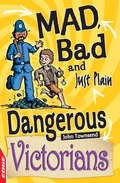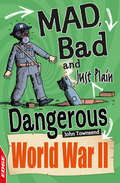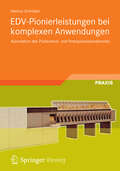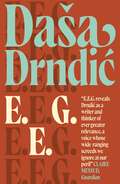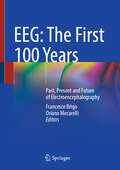- Table View
- List View
E. E. Constance Jones (Elements on Women in the History of Philosophy)
by Gary OstertagE. E. Constance Jones (1848–1922) published widely in philosophical logic and in ethics and moral psychology and was an active member of the British philosophical community from 1890 until her death. Her contributions to philosophical logic were wide-ranging and sophisticated, anticipating celebrated insights of later twentiethcentury philosophy of language and logic. In ethics, her writings on hedonism and practical reason, though influenced by her mentor, Henry Sidgwick, were innovative and merit further examination.
E. E. Cummings
by Susan CheeverFrom the author of American Bloomsbury ("Beguiling" --Publishers Weekly), Louisa May Alcott ("Fascinating . . . Another splendid piece of work with hidden depths by Susan Cheever"--Michael Korda), and Home Before Dark ("Moving and brilliantly restrained"--The New York Times Book Review), a major reassessment of the life and work of the novelist, painter, and playwright considered to be one of America's preeminent twentieth-century poets, our generation's beloved heretic. At the time of his death in 1962, at age sixty-eight, he was, after Robert Frost, the most widely read poet in the United States. E. E. Cummings was and remains controversial. He has been called "a master" (Malcolm Cowley); "hideous" (Edmund Wilson). James Dickey called him a "daringly original poet with more vitality and more sheer uncompromising talent than any other living American writer." In Susan Cheever's rich, illuminating biography we see Cummings's idyllic childhood years in a mythic part of Cambridge, Massachusetts (the Cummings house was within calling distance of Harvard professor William James, who first introduced Cummings's parents); his Calvinist father--distinguished Harvard professor and sternly religious minister of the Cambridge Congregational Church; his mother--loving, attentive, a source of encouragement, the aristocrat of the family, from Unitarian writers, judges, and adventurers. We see Cummings--slight, agile, playful, a product of a nineteenth-century New England childhood, bred to be flinty and determined; his love of nature ("here my enormous smallness entered Her illimitable being"); his sense of fun, laughter, mimicry; his desire from the get-go to stand conventional wisdom on its head, which he himself would often do, literally, to amuse. At Harvard, he roomed with John Dos Passos; befriended Lincoln Kirstein; read Latin, Greek, and French; earned two degrees; discovered alcohol, fast cars, and burlesque at the Old Howard Theater; and raged against the school's conservative, exclusionary upper-class rule by A. Lawrence Lowell. In Cheever's book we see that beneath Cummings's blissful, golden childhood the strains of sadness and rage were already at play. He grew into a dark young man and set out on a lifelong course of rebellion against conventional authority and the critical establishment, devouring the poetry of Ezra Pound, whose radical verses pushed Cummings away from the politeness of the traditional nature poem toward a more adventurous, sexually conscious form. We see that Cummings's self-imposed exile from Cambridge--a town he'd come to hate for its intellectualism, Puritan uptightness ("the Cambridge ladies," he wrote, "who live in furnished souls"), racism, and self-righteous xenophobia--seemed necessary for him as a man and a poet. Headstrong and cavalier, he volunteered as an ambulance driver in World War I, working alongside Hemingway, Joyce, and Ford Madox Ford . . . his ongoing stand against the imprisonment of his soul taking a literal turn when he was held in a makeshift prison for "undesirables and spies," an experience that became the basis for his novel, The Enormous Room, of which F. Scott Fitzgerald wrote: "Of all the work by young men since 1920--one book survives." We follow Cummings as he permanently flees to Greenwich Village to be among other modernist poets of the day--Marianne Moore, Hart Crane, Dylan Thomas--and we see the development of both the poet and his work against the backdrop of modernism and through the influences of his contemporaries: Stein, Amy Lowell, Joyce, and Pound.Cheever's fascinating book gives us the evolution of an artist whose writing was at the forefront of what was new and daring and bold in an America in transition.(With 28 pages of black-and-white images.)From the Hardcover edition.
E. H. Gombrich on Fresco Painting (Pocket Perspectives #0)
by Ernst GombrichAn interpretation of the history of mural painting from ancient Egypt to the twentieth century by one of most eminent art historians of all time, a writer who wielded huge influence over both his professional peers and a vast popular readership. Surprising, questioning, challenging, enriching: the Pocket Perspectives series presents timeless works by writers and thinkers who have shaped the conversation across the arts, visual culture, and history. Celebrating the undiminished vitality of their ideas today, these covetable and collectable little books embody the best of Thames & Hudson.
E. M. Forster: The Personal Voice (Routledge Revivals)
by John ColmerOriginally published in 1975, E. M. Forster: The Personal Voice draws on information about the life and works of E. M. Forster that came to light following his death in 1970. Exploring in particular the publication of Maurice in 1971, The Life to Come in 1972, and the Forster papers in King's College Library, Cambridge, this volume is an extensive study of E. M. Forster. It provides a comprehensive and detailed overview of Forster's work, his intellectual and literary background, his personality, and the reception of his work. E. M. Forster: The Personal Voice places Forster's works in their social and cultural context and provides an excellent insight into his development as a writer.
E.C. Drury: Agrarian Idealist
by Charles M. JohnstonIn a fiercely fought provincial election in 1919, a new political movement came to power in Ontario. The victorious party was the United Farmers of Ontario. Its leader, Ernest Charles Drury (1878-1968), became the province's eighth premier. Idealistic agrarian reformer, staunch temperance man, free-trade advocate, Simcoe County 'yeoman,' and progressive populist, Drury was a man of the people and of the land, inevitably tagged the Farmer Premier. In this biography, Charles M. Johnston follows the career of Drury through agrarian activism and partisan politics, and explores the personal and ideological forces that directed him. Drury began his career in the farm movement as leader of the Dominion Grange and Farmers' Alliance. He went on to act as the driving force behind the Canadian Council of Agriculture, and then co-founded the UFO in 1913. Activist though he was, Drury as a premier sought no dramatic departures from established political procedures. When others of his party did, notably J.J. Morrison and W.C. Good, Drury disavowed their class-consciousness and their formula of group government. Instead he advocated the creation of a people's party, based on what he called Broadening Out – an appeal to all citizens, regardless of class, occupation, or political stripe, who were seen to share the farmer's desire for a more humane, moral, and progressive society in the wake of the First World War. The question of Broadening Out was a controversial one within agrarian ranks, and it led to dissension among the leaders. This weakening of the party combined with the shrewd tactics of Howard Ferguson's Tories to bring about the Drury government's downfall in 1923. During its four years in power it had enacted some solid social welfare legislation, but its defeat was resounding. With it came the effective end of Drury's political career. Johnston offers a revealing study of a brief chapter in Ontario history and of the man whose principles and ideals shaped it.
E.E. Slutsky as Economist and Mathematician: Crossing the Limits of Knowledge (Routledge Studies In The History Of Economics Ser. #128)
by Vincent BarnettE.E. Slutsky is perhaps the Russian/Ukrainian economist most quoted by mainstream economists today. This is the first research monograph to examine the life and work of the internationally-renowned economist and mathematician. It does so from both a ‘history of economics’ perspective and a ‘history of science’ perspective, bringing these two strands together in order to demonstrate Slutsky’s enduring legacy as an innovative researcher and an influential intellectual. It also presents some of Slutsky’s lesser-known (and hitherto-unavailable) works in English translation.
E.H. Norman: His Life and Scholarship
by Roger W. BowenThe ashes of Herbert Norman now lie in the British cemetery at Rome, near those of Shelley and Keats. His distinguished life and tragic death, in April 1957, are recalled and examined in this book by scholars and diplomats from four countries--the United States, Japan, Canada, and Britain.Born in rural Japan the son of a Canadian missionary, Herbert Norman studied at the University of Toronto and went in 1933 to Cambridge University on a scholarship. There, in that intellectual hothouse where it seemed one had to choose politically between communism and fascism as the future of the West, he joined the Communist party--a move that became a crime later in the fixed and 'sightless' (as the editor describes them) eyes of his American accusers.According to Edwin Reischauer, later the US ambassador to Japan, 'his harassment by the American government was unforgiveable.' His suicide in Cairo, while Canadian ambassador to Nasser's Egypt during and after the delicate times of the Suez Crisis and the establishment of the UN peace-keeping force, raised broader questions for Lester Pearson--'the right, to say nothing of the propriety, of a foreign government to intervene' in Canadian affairs.Norman was also a renowned historian of Japan. His Japan's Emergence as a Modern State has been called a classic, and between 1946 and 1950, as head of the Canadian Liaison Mission in Tokyo, he was a close and friendly adviser to General Douglas MacArthur in his efforts to reconstitute that country. Both this work and his writings on Japan were sympathetic to human freedoms and democracy, and they too became controversial as sides congealed in the Cold War. Five papers in this book assess Norman's scholarly work in the historiography of Japan.Four lecture papers by Norman (three previously unpublished) are included which show his change from 'a doctrinaire Marxist to a Jeffersonian Liberal,' a change historians can accept as fact whereas intelligence agencies could not and remade Norman into a communist. He was not a spy, the editor concludes, and should be remembered as the hero of a modern tragedy.
E.S. Dallas in The Times
by Jenny Bourne Taylor Graham LawThis volume comprises of a substantial selection of E.S. Dallas’s journalism in The Times. Although his reviews were crucial not only in forging the literary reputations of upcoming writers such as different as George Eliot and Mary Elizabeth Braddon, but also in recalibrating the response to well-established authors such as Tennyson and Dickens, Eneas Sweetland Dallas (1827-79) remains arguably the most unjustly neglected of mid-Victorian critics. Although Dallas wrote for many other periodicals, it was his reviews in The Times that had the greatest impact on both the market for books and literary culture in the mid-Victorian period. This collection brings together an anthology of his contributions, as well as a newly written introduction, a comprehensive listing of the articles he submitted to The Times, critical apparatus to contextualise the materials, and a detailed chronology, reappraising Dallas’ biography. This volume will be of great interest to students and scholars of literary history.
ECESIS: An Interregional Economic-Demographic Model of the United States (Routledge Library Editions: Econometrics)
by Paul M. BeaumontOriginally published in 1989. ECESIS consists of 51 regional econometric models (one for each state and the District of Columbia) and a multiregional demographic model. Its distinguishing feature is the linking of sophisticated demographic accounts with sophisticated structural econometric models. This book, looking at how strong the interactions are between population dynamics and economic activity, determines to what extent the simultaneous economic-demographic interregional model provides improved projection and simulation properties over regional economic and demographic models used independently of one another.
EDGE: Bridge of Death
by Craig SimpsonIt's D-Day, 6th June 1944. Ten minutes after midnight. A small British force is flying over Occupied France on what is virtually a suicide mission - they must capture a bridge before German forces guarding it can blow it up. There's no room for error. They must cast fear aside in this race against time, told from both a British and German perspective. This title is published by Franklin Watts EDGE, which produces a range of books to get children reading with confidence. EDGE - for books kids can't put down.
EDGE: Duel In The Sky
by Tony BradmanA new German fighter ace is terrorising British planes over the trenches of France. It will take the bravery and sacrifice of a Britsh ace and the courage of a hero to bring him down. This title is published by Franklin Watts EDGE, which produces a range of books to get children reading with confidence. EDGE - for books kids can't put down.
EDGE: Iwo Jima
by Gary Smailes David CousensTake up your weapons and prepare to fight your own battle in these all-action, interactive adventures, in which you take part in epic battles from throughout history.It is 1945 and though Nazi Germany has been defeated, World War II rages on as Japan continues to fight. The US Marines have fought their way across the Pacific Ocean, defeating Japanese forces one small island at a time. The fighting has now reached Iwo Jima, a rocky volcanic island only 600 miles from Japan.You are a US Marine just about to land on the steep beaches of Iwo Jima. You must fight across the black sand to knockout the sea guns based there and take the island...
EDGE: Romans (Edge: Mad, Bad And Just Plain Dangerous Ser.)
by John TownsendTime to take a sideways look at the bizarre and outrageous from throughout history - and it's all TRUE!Which mad idea poisoned thousands of Romans?Which bad emperor was top of the crazy tree? What dangerous sport was most likely to get you killed?Find out the answers to these questions inside, along with lots of facts, quizzes, and other bonkers stuff as you take a bumpy journey into the darkest crannies of Roman history with Mad, Bad and Just Plain Dangerous!
EDGE: Run, Spy, Run!
by Craig SimpsonA British secret agent is photographing top secret German files when he is unexpectedly interrupted, and the alarm is raised. What follows is a desperate battle for survival as Jaques is pursued, hiding where he can and not able to trust anyone. He must find a path out of Occupied France to get the camera and film into British hands, nothing else - not even his own life - matters. This title is published by Franklin Watts EDGE, which produces a range of books to get children reading with confidence. EDGE - for books kids can't put down.
EDGE: Through Mud and Blood
by Tony BradmanIt is 1918. A British soldier, Bill Sparkes, is carrying an important message for American troops on the frontline. Sparkes is soon caught up in the fighting when the Americans are attacked. With bullets flying all around, Sparkes must find a way to support the Americans and stop the Germans breaking through... This title is published by Franklin Watts EDGE, which produces a range of books to get children reading with confidence. EDGE - for books kids can't put down.
EDGE: Tudors (Edge: Mad, Bad And Just Plain Dangerous Ser.)
by John TownsendTime to take a sideways look at the bizarre and outrageous from throughout history - and it's all TRUE!Which mad cure involved swallowing live frogs?Which bad ruler had the most heads chopped off at the Tower of London?Which Tudor invention do we still use today to get rid of dangerous waste?Find out the answers to these questions inside, along with lots of facts, quizzes, and other bonkers stuff as you take a bumpy journey into the darkest crannies of Tudor history with Mad, Bad and Just Plain Dangerous!
EDGE: Victorians
by John TownsendTime to take a sideways look at the bizarre and outrageous from throughout history - and it's all TRUE!Which new material got the Victorians building mad?Who was the bad guy that committed terrible crimes in London?Which dangerous job was banned for boys under 10?Find out the answers to these questions inside, along with lots of facts, quizzes, and other bonkers stuff as you take a bumpy journey into the darkest crannies of Victorian history with Mad, Bad and Just Plain Dangerous!
EDGE: World War II
by John TownsendTime to take a sideways look at the bizarre and outrageous from throughout history - and it's all TRUE!Which mad weapons were actually used during combat? Who was the bad guy in charge of the Nazi German air force? Which dangerous mission helped to capture the Nazis' new tank?Find out the answers to these questions inside, along with lots of facts, quizzes, and other bonkers stuff as you take a bumpy journey into the darkest crannies of World War II history with Mad, Bad and Just Plain Dangerous!
EDV-Pionierleistungen bei komplexen Anwendungen
by Helmut SchröderDas Buch möchte die Leser in die Frühzeit der elektronischen Datenverarbeitung (EDV), nämlich die 50er, 60er und 70er Jahre des vorigen Jahrhunderts führen, an die sich heute noch sehr viele ehemalige EDV-Mitarbeiter "als Pioniere" gut und wohl auch gern erinnern werden. Wie kann man diese Zeitphase bezeichnen? Es war eine einmalige innovative Phase, durch gravierende technische Neuerungen wurde eine enorme Aufbruchstimmung ausgelöst. Für das Projekt "Automatisierung des Postscheck- und Postsparkassendienstes" werden die komplexen Entwicklungen dargestellt. Es war seinerzeit das EDV-Projekt mit dem größten Geschäftspotential eines einzelnen Kunden in Deutschland. Die elektronischen Datenverarbeitung (EDV) wurde zunächst geprägt von Großrechnern, die mathematische Aufgaben für Großforschungsinstitute und Universitäten als "Rechenknechte" lösten. Kommerzielle Anwendungn wurden durch zu langsame Ein-/Ausgabeeinheiten verhindert. Der Postminister Richard Stücklen entwickelte die Idee, eine automatisierte Lösung auch für seinen Postscheck- und Postsparkassendienst zu nutzen. Das Buch beschreibt die Erkundungsphase, das Umdenken von der Lochkarte zur Belegverarbeitung sowie die allgemeine Situation der Ausbildung und dem Bau von Rechenzentren. Aus der Entwicklungsphase bis ca. 1972 werden die Anwendungslösungen und Systemlösungen dargestellt und kommentiert. Pionierleistungen waren vor allem die zügige Automation des Postsparkassendienstes, die erste europaweite Kontenführung mit Belegverarbeitung im Postscheckdienst und der einzige Belegleser-Massentest mit Magnetschriften in Deutschland.
EEG
by Daša Drndic*WINNER OF THE BEST TRANSLATED BOOK AWARD USA**SHORTLISTED FOR THE EBRD PRIZE**SHORTLISTED FOR THE OXFORD-WEIDENFELD PRIZE*"A writer and thinker of ever greater relevance, a voice whoSe wide-ranging screeds we ignore at our peril" CLAIRE MESSUD"Her work is of such power and scope that had she remained alive, she would have been a contender for the Nobel Prize in Literature" JOSIP NOVAKOVICH, Los Angeles Review of BooksAn urgent new novel about death, war and memory, and a bristling follow-on from Belladonna. In this extraordinary final work, Daša Drndic's combative, probing voice reaches new heights. In her relentless search for truth she delves into the darkest corners of our lives. And as she chastises, she also atones. Andreas Ban failed in his suicide attempt. Even as his body falters and his lungs constrict, he taps on the glass of history - an impenetrable case filled with silent figures - and tries to summon those imprisoned within. Mercilessly, fearlessly, he continues to dissect society and his environment, shunning all favours as he goes after the evils and hidden secrets of others. History remembers the names of perpetrators, not of the victims. Ban travels from Rijeka to Rovinj in nearby Istria, from Belgrade to Toronto to Tirana, from Parisian avenues to Italian palazzi. Ghosts follow him wherever he goes: chess grandmasters who disappeared during WWII; the lost inhabitants of Latvia; war criminals who found work in the C.I.A. and died peacefully in their beds. Ban's family is with him too: those he has lost and those with one foot in the grave. As if left with only a few pieces in a chess game, Andreas Ban plays a stunning last match against Death.Translated from the Croatian by Celia Hawkesworth
EEG: Past, Present and Future of Electroencephalography
by Oriano Mecarelli Francesco BrigoAuthored by leading experts, this book explores the key milestones in the 100-year history of the electroencephalogram (EEG). It provides a detailed account of its origins, global development, clinical applications, and lasting impact on neuroscience. By tracing its evolution, the book underscores the EEG&’s enduring relevance. What distinguishes this volume is its dynamic and forward-looking approach. Rather than a traditional historical account, it presents the story of the EEG as an evolving narrative—connecting past discoveries with future possibilities. With advancements in digital technology, machine learning, and artificial intelligence, the EEG remains central to neuroscientific research and a critical diagnostic tool in various medical fields. This book offers valuable insights into the EEG&’s contributions to modern neuroscience and its continued influence. It is intended for neurologists, neuroscientists, neuropsychologists, neurophysiologists, EEG technicians, and medical historians, as well as anyone interested in the development of neuroscience and brain research.
EHI01 Aamul Parivartanvaadi Pravattiyan Rashtravaad aur Mahatama Gandhi - IGNOU
by IgnouThis unit will tell the readers about the growth of marxism and socialism. This also explains about the scientific socialism. The first world war took place in the same time so it traces the causes of world war also. Russian revolution, causes and effects have been discussed in detail for the benefit of student of history. This era also saw the rise of revolutionaries and its effect on India can also be seen. Readers will the the emergence of Gandhi at the end of the unit.
EHI01 Rashtravaad Vishwa Yudhdho ke Madhya-2 - IGNOU
by IgnouThis unit traces the Indian Naitional Movement during 1920 and 1930. Unit 23 studies the effect of literature on National movement. further chapters discuss about revolutionalry and terrorist movement in the late 1920. Congress started the second revolution in 1930. causes of start of non cooperation movement have also been discussed. communist moement has also been analysed in this unit.
EHI01 Rastravad Vishwa Yudhdho ke Dauraan-1 - IGNOU
by IgnouThis unit discusses about the constitutional development happening between 1892 to 1920. Non cooperation movement and khilafat movement are discussed in detail. Regional movements like akali and non brahmin movement have also been discussed. swaraj party, its rise and fall has been discussed. The rise of communalism during national movement have also been analysed in this unit.
EHI01 Sangathit Rashtravaad ka Uday - IGNOU
by IgnouThis section traces the effort of britishers to strengthen them after revolt of 1857. The emergence of of various movements are also covered in this part. This unit explores the causes of the rise of congress. this unit will also make the readers aware of swadeshi movement.
